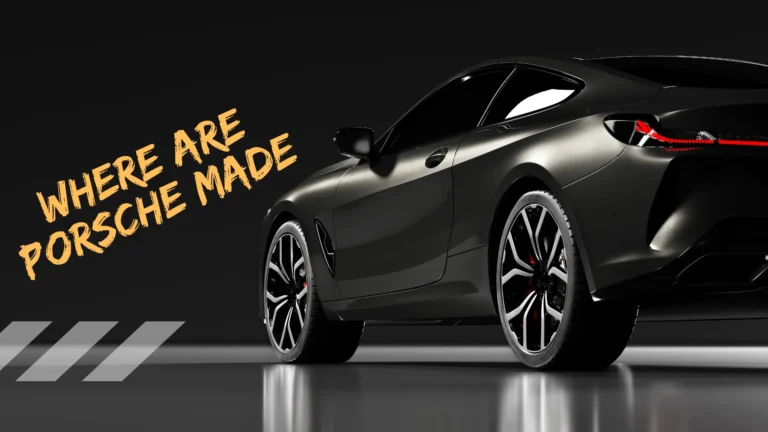Where are Jeeps Made

Jeep, an iconic American automotive brand, is renowned for its rugged off-road vehicles and adventurous spirit. While Jeep’s origins are deeply rooted in the United States, its manufacturing has expanded globally to meet growing demand. Today, Jeep production spans multiple continents, ensuring accessibility to enthusiasts worldwide. This article explores where Jeeps are made, highlighting key manufacturing plants and Jeep’s global production strategy.
Jeep’s Manufacturing Origins
The Birth of Jeep
The Jeep brand originated during World War II when the U.S. military required a lightweight, durable reconnaissance vehicle. Willys-Overland, based in Toledo, Ohio, won the contract and began mass-producing what became the legendary Willys MB. This early Jeep model was instrumental in military operations, earning a reputation for reliability and versatility.
Post-War Expansion
After World War II, Jeep transitioned from military use to civilian markets. The success of the Willys MB led to the development of consumer-friendly models, such as the Jeep CJ (Civilian Jeep). With growing demand, Jeep expanded its production capabilities, ensuring a steady supply of vehicles for both domestic and international markets. While Toledo remained the heart of Jeep’s production, new facilities were established to accommodate increasing popularity.
Major Jeep Manufacturing Facilities in the USA
Toledo Assembly Complex, Ohio
Toledo, Ohio, is synonymous with Jeep. The Toledo Assembly Complex has been the primary production hub for Jeep since its inception. Today, it manufactures some of Jeep’s most iconic models, including the Jeep Wrangler and Jeep Gladiator. The plant has undergone multiple expansions and modernizations to keep up with evolving automotive technologies and consumer expectations.
Jefferson North Assembly Plant, Michigan
Located in Detroit, Michigan, the Jefferson North Assembly Plant plays a crucial role in Jeep’s manufacturing operations. This facility is responsible for producing the Jeep Grand Cherokee, one of the brand’s most popular SUVs. With advanced automation and state-of-the-art production lines, the plant ensures that each vehicle meets high-quality standards.
Belvidere Assembly Plant, Illinois
The Belvidere Assembly Plant in Illinois has been instrumental in Jeep’s production strategy. Over the years, it has manufactured various Jeep models, including the Jeep Cherokee. This facility represents Jeep’s commitment to adapting to market trends by shifting production focus based on consumer demand.
International Jeep Manufacturing Facilities
Melfi Assembly Plant, Italy
Jeep’s expansion into Europe led to the establishment of the Melfi Assembly Plant in Italy. This facility produces models such as the Jeep Renegade and Jeep Compass, catering specifically to European consumers. The plant integrates advanced engineering and local manufacturing expertise to ensure vehicles meet regional safety and environmental standards.
Goiana Assembly Plant, Brazil
To serve South American markets effectively, Jeep operates a manufacturing facility in Goiana, Brazil. The plant produces models like the Jeep Renegade and Jeep Compass, offering tailored features to meet the preferences of Latin American consumers. By manufacturing locally, Jeep reduces production costs and improves accessibility for customers in the region.
Guangzhou Assembly Plant, China
China represents one of the world’s largest automotive markets, prompting Jeep to establish a manufacturing presence there. The Guangzhou Assembly Plant ensures that Jeep models comply with Chinese regulations and market preferences. This localized production strategy enhances Jeep’s competitiveness in the Asian market while reducing import tariffs and shipping costs.
Factors Influencing Jeep’s Global Manufacturing Strategy
Market Demand and Proximity
Jeep strategically positions its manufacturing plants close to high-demand markets. This approach helps minimize logistical costs and ensures faster delivery times. By manufacturing vehicles in key regions, Jeep can efficiently cater to local customers without relying heavily on exports.
Economic and Trade Considerations
Economic factors play a significant role in Jeep’s global manufacturing decisions. Labor costs, government incentives, and trade policies influence where Jeep chooses to establish production facilities. By selecting cost-effective locations, Jeep maintains competitive pricing while ensuring operational efficiency.
Quality Control and Innovation
Regardless of location, Jeep maintains strict quality control measures across all its manufacturing plants. The brand utilizes advanced automation, robotics, and 3D printing technologies to enhance precision and efficiency. These innovations ensure that every Jeep vehicle upholds the brand’s legacy of durability, reliability, and off-road capability.
Conclusion
Jeep’s journey from a wartime military vehicle to a global automotive powerhouse is a testament to its adaptability and innovation. While its heart remains in Toledo, Ohio, Jeep’s production network spans multiple continents, ensuring accessibility to enthusiasts worldwide. Whether manufactured in the U.S., Europe, South America, or Asia, each Jeep vehicle embodies the brand’s core values of adventure, resilience, and superior engineering. As Jeep continues to expand its global footprint, it remains committed to producing high-quality, rugged vehicles that inspire drivers to explore the world with confidence.





